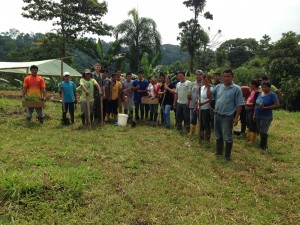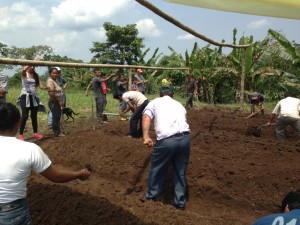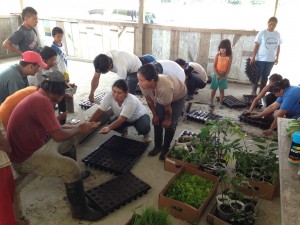 Earlier this month I traveled to the amazon region to do some workshops on “kitchen gardens”. In communities outside of the town of Lumbaqui man people grow only cacao and coffee, a cash crop that they can sell. Unfortunately because of lack of transportation many of them only can sell to middlemen that come and pay a fraction of what the product is worth ( they sell coffee at 15 cents a pound). They also grow plantains and as starchy staple foods, while these will fill them up they are lacking in many essential vitamins and minerals and the malnutrition is visible in the people living in those areas.
Earlier this month I traveled to the amazon region to do some workshops on “kitchen gardens”. In communities outside of the town of Lumbaqui man people grow only cacao and coffee, a cash crop that they can sell. Unfortunately because of lack of transportation many of them only can sell to middlemen that come and pay a fraction of what the product is worth ( they sell coffee at 15 cents a pound). They also grow plantains and as starchy staple foods, while these will fill them up they are lacking in many essential vitamins and minerals and the malnutrition is visible in the people living in those areas.
Much of the produce that is sold in that area has travelled distances without refrigeration and in the heat of the rainforest things begin to spoil quickly and as a result is more expensive.
The idea behind the trainings was to get people to grow more of their own food for their own health and development of children and if they can produce extra they will be able to sell to their neighbors. Many of the indigenous groups of the amazon were hunters and gatherers and never needed to develop intricate farming techniques, with changing times people are now tied to one place and do not have the freedom to travel to where they are able to harvest from nature itself.
Give someone a fish and you can feed them for a day, teach someone to fish and you can feed them for a lifetime…..but it would help to give them a fishing line and some hooks.The people in these communities did not have shovels or hoes to work with so I brought basic hand tools, seed trays, seeds, transplants and visual aids. We talked about seed saving and planting seed trays, basic pest and disease management, improving soils and making basic natural fertilizers and compost. It was very well received and people worked hard in the hot sun preparing and planting the community garden plot. We worked together using their expertise in the area and my areas of training to plant some test plots that will show us what kinds of fruits and vegetables can be grown in that area. We planted some traditional garden crops like cherry tomato, hot peppers, onions and then some more tropical garden plants like papaya, ginger, and taro root. The only new crop that I introduced was sweet potatoes. They are very accustomed to eating starchy tubers and sweet potato is a highly nutritious prolific plant with few pest and diseases and you can even eat the leaves!
and some hooks.The people in these communities did not have shovels or hoes to work with so I brought basic hand tools, seed trays, seeds, transplants and visual aids. We talked about seed saving and planting seed trays, basic pest and disease management, improving soils and making basic natural fertilizers and compost. It was very well received and people worked hard in the hot sun preparing and planting the community garden plot. We worked together using their expertise in the area and my areas of training to plant some test plots that will show us what kinds of fruits and vegetables can be grown in that area. We planted some traditional garden crops like cherry tomato, hot peppers, onions and then some more tropical garden plants like papaya, ginger, and taro root. The only new crop that I introduced was sweet potatoes. They are very accustomed to eating starchy tubers and sweet potato is a highly nutritious prolific plant with few pest and diseases and you can even eat the leaves!
 In the process of planning these trainings I visited a government plant nursery and made friends with the manager who ended up donating 100 fruit trees and some compost and came to the trainings with 4 interns that are studying agronomy. Along with the fruit trees that I had grown out in my greenhouse in quito we planted some of the local trees and made sure that every family could take home a several fruit trees and transplants to plant on their own.
In the process of planning these trainings I visited a government plant nursery and made friends with the manager who ended up donating 100 fruit trees and some compost and came to the trainings with 4 interns that are studying agronomy. Along with the fruit trees that I had grown out in my greenhouse in quito we planted some of the local trees and made sure that every family could take home a several fruit trees and transplants to plant on their own.
In one of the villages called rio tigre, they prepared maito for us- Tilapia wrapped in giant leaves and cooked over hot coals.
At the beginning of march I will go back for follow ups with the communities I first visited and to continue doing more workshops in new communities.Two days after getting back from this trip I helped work an exotic fruits show at the Quito Botanic gardens featuring hundreds of different fruits from around the world.


